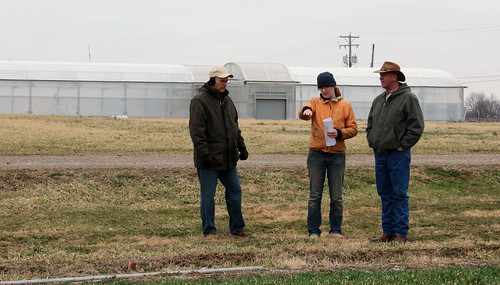
The University of Kentucky is using a Conservation Innovation Grant to improve the efficiency of seasonal high tunnels. NRCS and UK staff view a water line with a high tunnel in the background. NRCS photo.
Seasonal high tunnels have emerged in the past few years as an important tool for farmers wanting to extend their growing seasons. Right now, thanks to a Conservation Innovation Grant from USDA, a University of Kentucky professor is studying them – and how they can be made more efficient.
Krista Jacobsen, an assistant professor of horticulture, is studying the soil inside of high tunnels and the possibilities of catching rainwater to irrigate crops inside of them. High tunnels are plastic-covered structures that enable farmers to have crops ready earlier or later in the season.
In high tunnels, plants are grown directly in the ground, and the sun’s heat regulates the temperature inside. Since 2009, USDA’s Natural Resources Conservation Service has provided assistance to help producers construct more than 9,000 high tunnels on farms around the country. In the past two years, more than 400 have been installed in Kentucky.
Many farmers use drip irrigation to water crops in high tunnels. The water typically comes from natural sources, such as ponds or springs, or from city water. But city water can often cost more and the chemicals sometimes added to it aren’t good for plants because they can cause a buildup of salts, said John Graham, a soil health specialist.
Jacobsen is looking at a device that will catch rainwater and then make it available to irrigate crops. This puts natural water to use, simulating rainfall on traditional field crops. Using rainwater also conserves water by not using underground sources.”
“A main focus of this project is decreasing the ‘water footprint’ of high tunnel production for a variety of locations in Kentucky,” she said. “In areas with access to city water, this means reducing the use of drinking-quality water for irrigation purposes.”
And in rural areas, it offers a low-cost and simple solution for farmers, she said.
“Our project focuses on developing rainwater capture systems that are scale-appropriate to the smaller high tunnels popping up throughout Appalachia, and training farmers on efficient irrigation practices using relatively low-cost soil water monitoring equipment,” Jacobsen said.
The first of the rainwater catchment devices developed and constructed by the university will be installed and demonstrated for this fall and winter crop.
These irrigation systems rely on low-pressure irrigation systems powered by gravity, something the university is studying at two demonstration sites, a partnership with Grow Appalachia in London, Kentucky, and the University of Kentucky Robinson Center for Appalachian Resources for Sustainability in Jackson, Kentucky.
The Conservation Innovation Grant program helps groups, like the University of Kentucky, demonstrate innovative approaches to improve soil quality, air quality, and water quality, conserve energy, and enhance wildlife habitat in balance with productive agricultural systems.
Just yesterday, Agriculture Secretary Tom Vilsack announced USDA is investing $15.7 million through grants to 47 entities. Find out more by listening to NRCS Chief Jason Weller describe the program and some of the grantees.
No comments:
Post a Comment